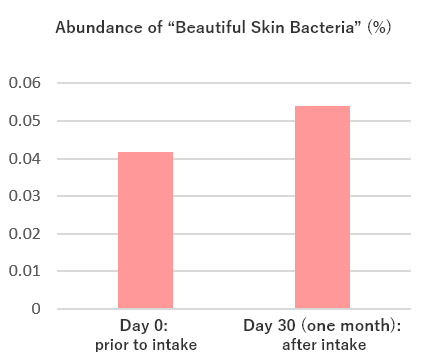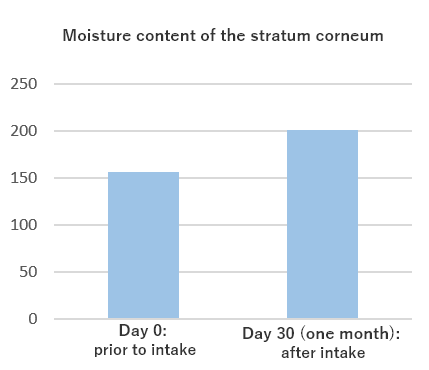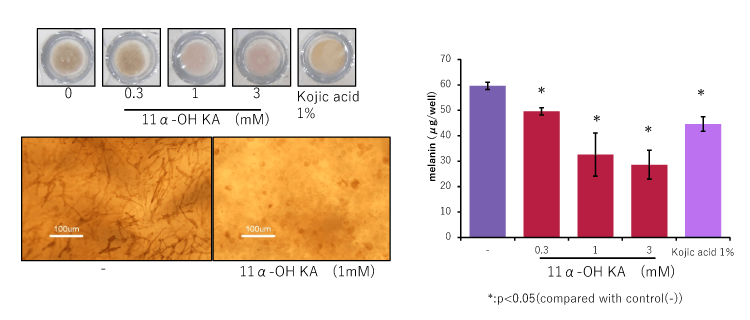Today, a wide variety of products and services have been developed across the boundaries of industries and sectors. To further promote research and development, we need to go back to our original mission of "making the skin more beautiful and healthier" and destroy the stereotype of what cosmetic products should be.
Changes in the living environment, an excessively hygiene-conscious culture, and the advancement of clothing-related technology have caused many people to suffer from various skin problems, including atopic dermatitis and dry skin. Those with sensitive skin, such as elderly people and babies in particular, may develop more serious skin disorders.
To resolve these problems, we have been promoting research to apply cosmetic effects to clothing. In designing the formula of cleansing oil, importance should be placed not only on "cleansing capabilities" but also on "ease to wash the cleansing agent off." To reduce a feeling of discomfort when it is washed off and prevent oil ingredients from remaining on the face, cleansing oil needs to be designed to change its ingredients into very fine particles (microemulsion). Our moist fiber technology, which enables oil ingredients to be made into a fine emulsion by gentle agitation, is expected to increase the stability and surface area of microemulsion.
We, in collaboration with Omikenshi Co., Ltd., have succeeded in incorporating highly concentrated cosmetic ingredients into fibers during the production process of fibers, using the microemulsion method. The formulation ingredients have been proved to have the efficacy and effects that are required for cosmetic products, including showing a certain level of resistance to laundry and increasing the moisture content of skin by wearing clothes made of the fibers.
Making use of this technology, we have been promoting the development of fiber products combined with cosmetic functions.

| Patent Application No. 2015-139436 | Antibacterial rayon fiber and its products |
"Some women continue to have beautiful skin after getting older. What makes the difference between such women and others?" Focusing on this matter, we have conducted research for many years. With the cooperation of women in their 40s to 50s, we analyzed their skin parameters (moisture content, resilience, etc.), diets, living environments, bacterial flora (in the skin, intestine, and oral cavity), etc." It was found that women with beautiful skin had a lot of specific bacterial flora—so-called "Beautiful Skin Bacteria"—in the intestine. With focus on Beautiful Skin Bacteria, we have successfully developed "Floracontroller ISR," a unique ingredient that controls intestinal flora and thereby makes the skin more beautiful.
With the cooperation of women aged 40 to 59 (those who had not received medical cosmetic treatment within one year and who had not taken antibiotics within one month), we conducted a study of their skin parameters (19 items, including moisture content and resilience), physical activity status, diets, sport habits, and bacterial flora in the skin, intestine, and oral cavity. We calculated skin scores from the above skin parameters using our unique assessment method, created definitions for a "beautiful skin group" and a "general group" based on the scores, and conducted comparison analysis for each item. (Significant difference: p<0.05 level) Analysis results show that there was no significant difference in age between the beautiful skin group and the general group, but that the beautiful skin group, more than the general group, had higher beautiful skin scores and higher percentages of specific intestinal bacteria called "Beautiful Skin Bacteria."
To enhance the beautiful skin scores by increasing the number of Beautiful Skin Bacteria discovered in the above-mentioned study, the percentage of which was significantly higher in the beautiful skin group than the general group, we developed a supplement with special formulation to increase the number of Beautiful Skin Bacteria and conducted a demonstration test. We asked 12 women aged 40 to 59 (those who had not received medical cosmetic treatment within one year and who had not taken antibiotics within one month) to take the supplement we have developed, and we compared their skin parameters and state of intestinal bacterial flora at three points: (1) prior to intake, (2) after one month of intake, and (3) one month after the cease of intake.

The test comparing intestinal bacterial flora between prior to intake of supplement and after one month of intake indicates that the number of Beautiful Skin Bacteria—the percentage of which has proved to be significantly higher in the beautiful skin group than the general group—increased by about 25% (p=0.027) (Figure 2). The moisture content of skin increased by about 30% (p=0.043) (Figure 3), and skin resilience was also enhanced about 8% (p=0.0032) (Figure 4). Accordingly, it has been confirmed that this supplement is effective as a probiotics supplement in making the skin more beautiful by increasing the number of Beautiful Skin Bacteria and enhancing moisture content and resilience of the skin. We filed a patent application for the invention of the technology called "Floracontroller ISR for Drinking" in September 2019.



"Bacterial flora," represented by intestinal flora, has attracted a great deal of attention from the health and beauty industries. There are more than 200 kinds of bacteria living in the skin, which are called "skin flora."

Representative types of skin flora are Staphylococcus epidermidis (S. epidemidis), Staphylococcus aureus (S. aureus), and Cutibacterium acne (C. acnes). S. aureus in particular is said to secrete a toxin, causing inflammation. In contrast, S. epidemidis has the positive effect of moisturizing the skin, making the skin mildly acidic and thereby inhibiting various bacteria from growing. Research has recently found that bacteria living in the skin play a significant role in maintaining the skin in good condition.
Conventionally, it was believed that all bacteria should be killed. Considering it important to live symbiotically with bacteria, however, we have been promoting the development of technology to control skin flora.
Focusing attention on S. aureus and S. epidemidis as ingredients to control skin flora, we worked on the selective assessment of their activities based on the measurements of MIC (minimum inhibitory concentration) (Figure 1). Research over the last few years has found that when combined with certain ingredients under certain conditions, S. epidemidis did not inhibit the activity of other bacteria (>1,000 µg/mL), while S. aureus significantly inhibited the activity of other bacteria (<31.3 µg/mL). Based on these findings, we have created "Floracontroller FC161."

Our research has shown that even if it is combined with cosmetics, Floracontroller FC161 does not show any effect and that it is necessary to consider a formulation that allows the ingredient to remain on the skin surface. To address this issue, we worked to design a formulation that optimizes the oriented state of Floracontroller FC161 in terms of both quality and efficacy. We also developed an assessment system to reproduce skin flora on the human skin, performed co-culture* of multiple types of bacteria, and developed technology to assess their abundance ratio (Figure 2). We found that cosmetic products formulated with Floracontroller FC161 were proven to significantly increase the abundance ratio of S. epidemidis, compared to those not formulated with Floracontroller FC161. This research was implemented with the guidance and cooperation of Dr. Toshihiro Nagao, Osaka Research Institute of Industrial Science and Technology.
* Co-culture refers to a method to sow S. epidemidis and S. aureus on an NB agar plate and then apply cosmetics to it for co-culture.

| 2015 | The 11th International Symposium on Biocatalysis and Agricultural Biotechnology | Selective Antibacterial Activity of Palmitoleic Acid Useful for Possible Prevention of Atopic Dermatitis. |
Our research has found that a skin lotion containing rosemary extract can be effective in gently reducing the thickness of the old stratum corneum without destroying the balance of epidermal cells and thereby reducing perceived skin thickness and dullness by enhancing the activity of kallikrein (KLK), an enzyme capable of exfoliating the dead skin cells and promoting the proliferation of epidermal keratinocytes. We will apply these findings to the development of products. We made a poster presentation on these research results at the 25th IFSCC Conference 2019 that took place in Milan from September 30 to October 2, 2019.

At the 2016 IFSCC Congress held in Orlando, Florida, we presented a study showing that a decrease in activity of KLK-5, an enzyme capable of exfoliating the dead skin cells, is correlated to skin dullness, which tends to appear with age, and that skin dullness can be relieved by enhancing the activity of KLK-5.
In continued relevant research, we have found that a skin lotion containing rosemary extract is effective in relieving the perceived skin dullness and skin thickness by enhancing the activity of KLK-7 in the human stratum corneum and thereby gently reducing the thickness of old stratum corneum, which does not easily fall out. It has also been confirmed that women, more than men, are more sensitive to changes in skin conditions, such as skin dullness and skin thickness.


Conventionally, rosemary extract is widely known for having anti-inflammatory, anti-bacterial and other effects. Our research has discovered new effects of rosemary extract, as mentioned above. This research confirms that rosemary extract has the effect of allowing epidermal keratinocyte to proliferate. Therefore, it can be considered that a skin lotion formulated with rosemary extract is also capable of not only exfoliating the dead skin cells but also supplying epidermal cells. This means that such lotion is expected to be effective in regulating epidermal turnover and relieving perceived skin dullness and thickness. We will apply these results to the development of products.
| 2019 | Improvement of epidermal turnover focused on exfoliation enzymes by botanical extract | The 25th IFSCC Conference, Milan, 2019 |
Finishing powder, including loose powder and pressed powder, accounts for a large part of formulated products.
Since powder has the property of absorbing water or oil, the use of finishing powder is highly effective in absorbing any extra oil, alleviating
greasy skin and helping makeup last longer. Because of its property of absorbing water or oil, finishing powder may make the skin dry or make a face made up in the morning get dried out in the late afternoon.
To solve this problem, we worked on the development of an ingredient for makeup that takes care of the skin and finally developed a moisturizing powder that prevents the skin from easily getting dry. (Figure 1)

Infiltrating moisturizer into powder with fine pores, like a sponge, makes it possible for the powder to contain an unusually high amount of moisturizer. As the powder adapts to the skin, the moisturizer contained in the powder penetrates deep into the skin. (Figure 2)
We identified the amount that maximizes the effects of the moisturizer in loose powder by continuously measuring the skin’s moisture level. Based on the research results, we have commercialized an item that takes care of the skin while serving as a makeup product.

When the skin is exposed to ultraviolet light, intraepidermal melanocytes produce the pigment called melanin. Melanin protects the skin against damage from ultraviolet light. However, an excessive amount of melanin causes blemishes or dullness in color.
In collaboration with the National Institutes of Biomedical Innovation, Health and Nutrition (the former National Institute of Biomedical Innovation; "NIBIOHN"), we conducted the screening of plant extracts that inhibit melanogenesis. NIBIOHN has the Research Center for Medical Plant Resources, which performs research and development on technology related to the cultivation and breeding of medical plants, as well as chemical and biological evaluations. The Center stores a wide variety of botanical resources collected from both within Japan and abroad. Taking advantage of these resources, we tested over 200 plants for inhibitory effects on melanin synthesis and identified Callicarpa longissimi. Callicarpa longissimi extract has the effect of inhibiting the expression of the gene of tyrosinase, an enzyme involved in the production of melanin.
| 2016 | Journal of Natural Medicines 2016,70:28-35 | Callicarpa longissima extract,carnosolrich,potently inhibits melanogenesis in B16F10 melanoma cells |
Our research in collaboration with NIBIOHN has also found that Pteris dispar is effective in inhibiting the production of melanin. We identified that its active ingredients areent-11α-Hydroxy-15-oxo-kaur-16-en-19-oic Acid (11αOH-KA). To confirm that these ingredients inhibit the production of melanin, we conducted tests using B16F10 cells (Figure 1) and a 3D model of the skin (Figure 2). An analysis of the mechanism shows that the ingredients inhibit the expression of the gene of tyrosinase, an enzyme involved in the production of melanin. (Figure 3)



We are currently considering using Pteris dispar as an ingredient for cosmetic products. Since Pteris dispar is a rare plant, we have started to grow the plant from the perspective of securing resources.

| 2015 | The 62nd Annual Meeting of Japanese Society of Pharmacognosy | Pteris dispar extract has the effect of inhibiting the production of melanin. |
| 2017 | 48th Annual Meeting of Union of Chemistry-Related Societies in Chubu Area, Japan | The ent-Kaurene compound of Pteris dispar has the effect of inhibiting the production of melanin. |
| Patent number: 5946510 | Melanin production inhibitor, cosmetic, and method for producing melanin production inhibitor |
| 2017年 | Skin pharmacology and physiology 2017;30:205-215 | The Importance of 11α-OH, 15-oxo, and 16-en Moieties of 11α-Hydroxy-15-oxo-kaur-16-en-19-oic Acid in Its Inhibitory Activity on Melanogenesis |
* An example of research has been provided.